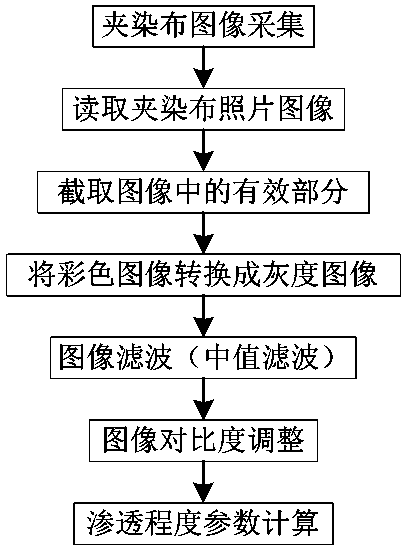Image recognition based selection method of dyes for one-bath multi-color tie-dyeing of silk fabrics
A technology for real silk fabrics and image recognition, which is applied in the processing of textile materials, local processing of textile materials, dyeing methods, etc., can solve the problems of large workload, limitation, and inability to calculate the IOB value in half-dyeing time, and achieves simple and convenient operation. Effect
- Summary
- Abstract
- Description
- Claims
- Application Information
AI Technical Summary
Problems solved by technology
Method used
Image
Examples
Embodiment 1
[0021] The selected dyes in this embodiment are: reactive violet X-2R and weakly acidic fruit green 3GM.
[0022] Fabric dyeing: Take 9 pieces of silk fabrics cut into 10cm×10cm size, stack them neatly, sandwich them between two splints of the same shape and size, which are not easy to deform under dyeing conditions, and do not absorb dyes, and fix them with a constant clamping force . Put the clamped silk fabric into the dye bath for dyeing. The fixed dyeing conditions are: dye dosage 5% owf, bath ratio: 1:20, dyeing temperature: 95°C, pH value 4, dyeing time 30min. Take it out after dyeing, remove the splint, dry the fabric, and perform image processing after flattening.
[0023] See attached figure 1 , which is a workflow diagram of the image processing steps in this embodiment. In this embodiment, a digital camera is used to take pictures of the fabric obtained by clamp dyeing under the same conditions, and the initial images are collected. Use image processing techno...
PUM
 Login to View More
Login to View More Abstract
Description
Claims
Application Information
 Login to View More
Login to View More - R&D Engineer
- R&D Manager
- IP Professional
- Industry Leading Data Capabilities
- Powerful AI technology
- Patent DNA Extraction
Browse by: Latest US Patents, China's latest patents, Technical Efficacy Thesaurus, Application Domain, Technology Topic, Popular Technical Reports.
© 2024 PatSnap. All rights reserved.Legal|Privacy policy|Modern Slavery Act Transparency Statement|Sitemap|About US| Contact US: help@patsnap.com










